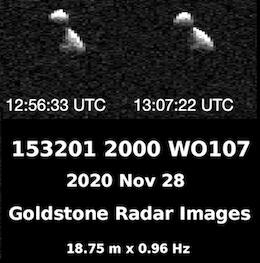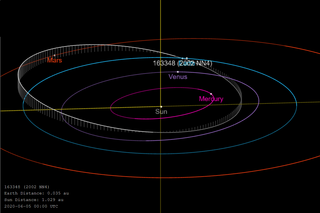
4183 Cuno, provisional designation 1959 LM, is an eccentric, rare-type asteroid, classified as near-Earth object and potentially hazardous asteroid of the Apollo group, and measures approximately 4 kilometers in diameter.

A potentially hazardous object (PHO) is a near-Earth object – either an asteroid or a comet – with an orbit that can make close approaches to the Earth and which is large enough to cause significant regional damage in the event of impact. They are conventionally defined as having a minimum orbit intersection distance with Earth of less than 0.05 astronomical units and an absolute magnitude of 22 or brighter, the latter of which roughly corresponds to a size larger than 140 meters. More than 99% of the known potentially hazardous objects are no impact threat over the next 100 years. As of September 2022, just 17 of the known potentially hazardous objects listed on the Sentry Risk Table could not be excluded as potential threats over the next hundred years. Over hundreds if not thousands of years though, the orbits of some "potentially hazardous" asteroids can evolve to live up to their namesake.
2004 TG10, is an eccentric asteroid, classified as near-Earth object and potentially hazardous asteroid of the Apollo group. First observed by the Spacewatch survey on 8 October 2004, it may be a fragment of Comet Encke and is the source of the Northern Taurids meteor shower seen annually in November and the June Beta Taurids. The asteroid may be larger than one kilometer in diameter.

(419624) 2010 SO16 is a sub-kilometer asteroid in a co-orbital configuration with Earth, classified as near-Earth object and potentially hazardous asteroid of the Apollo group. It was discovered by the Wide-field Infrared Survey Explorer space telescope (WISE) on 17 September 2010.

(7482) 1994 PC1 is a stony asteroid, classified as near-Earth object and potentially hazardous asteroid of the Apollo group, approximately 1.1 kilometers in diameter. It was discovered on 9 August 1994, by astronomer Robert McNaught at the Siding Spring Observatory in Coonabarabran, Australia. With an observation arc of 47 years it has a very well known orbit and was observed by Goldstone radar in January 1997. The 2022 approach has been observed every month since August 2021.
(242450) 2004 QY2 (prov. designation:2004 QY2) is an asteroid on an eccentric orbit, classified as near-Earth object and potentially hazardous asteroid of the Apollo group, approximately 3 kilometers (2 miles) in diameter. It was discovered on 20 August 2004 by the Siding Spring Survey at an apparent magnitude of 16.5 using the 0.5-metre (20 in) Uppsala Southern Schmidt Telescope. It is one of the largest potentially hazardous asteroids known to exist.
(391211) 2006 HZ51 is a bright, sub-kilometer asteroid on an eccentric orbit, classified as a near-Earth object and a potentially hazardous asteroid of the Amor group. It was discovered on 27 April 2006, by astronomers of the Catalina Sky Survey conducted at Mount Lemmon Observatory, Arizona, United States. During preliminary observations, it was thought to have a small chance of impacting Earth in 2008. The asteroid measures approximately half a kilometer in diameter and has an exceptionally high albedo.

(153201) 2000 WO107 is a sub-kilometer asteroid, classified as near-Earth object and potentially hazardous asteroid of the Aten group with a very well determined orbit. It was discovered on 29 November 2000, by astronomers of the Lincoln Near-Earth Asteroid Research (LINEAR) at the Lincoln Laboratory's Experimental Test Site near Socorro, New Mexico, in the United States. It is a contact binary.
(89830) 2002 CE, provisional designation 2002 CE, is a stony asteroid, classified as near-Earth object and potentially hazardous asteroid of the Amor group, approximately 3.1 kilometers in diameter. It was discovered on 1 February 2002, by astronomers of the LINEAR program at Lincoln Laboratory's Experimental Test Site near Socorro, New Mexico, in the United States. This asteroid is one of the largest potentially hazardous asteroid known to exist.
(90075) 2002 VU94, provisional designation 2002 VU94, is an asteroid on an eccentric orbit, classified as near-Earth object and potentially hazardous asteroid of the Apollo group, approximately 2.5 kilometers in diameter. It was discovered on 13 November 2002, by astronomers of the Near-Earth Asteroid Tracking program at Palomar Observatory in California, United States. It is one of the largest potentially hazardous asteroids known.
(159857) 2004 LJ1, provisional designation 2004 LJ1, is an asteroid on an eccentric orbit, classified as near-Earth object and potentially hazardous asteroid of the Apollo group, approximately 3 kilometers in diameter. The asteroid was discovered on 10 June 2004, by astronomers of the LINEAR program at Lincoln Laboratory's Experimental Test Site near Socorro, New Mexico, in the United States. It is one of the largest potentially hazardous asteroids known to exist.
(85713) 1998 SS49, provisional designation 1998 SS49, is an asteroid on an eccentric orbit, classified as near-Earth object and potentially hazardous asteroid of the Apollo group, approximately 3 kilometers (1.9 miles) in diameter. The asteroid was discovered on 29 September 1998, by astronomers of the LINEAR program at Lincoln Laboratory's Experimental Test Site near Socorro, New Mexico, in the United States. It is one of the largest potentially hazardous asteroids and has a notably low Earth-MOID of less than the distance to the Moon.
(111253) 2001 XU10, provisional designation 2001 XU10, is an asteroid on an eccentric orbit, classified as near-Earth object and potentially hazardous asteroid of the Apollo group, approximately 3 kilometers in diameter. It was discovered on 9 December 2001, by astronomers of the LINEAR program at Lincoln Laboratory's Experimental Test Site near Socorro, New Mexico, in the United States. The asteroid is one of the largest potentially hazardous asteroids.

(505657) 2014 SR339, provisional designation 2014 SR339, is a dark and elongated asteroid, classified as near-Earth object and potentially hazardous asteroid of the Apollo group, approximately 970 meters (3,200 feet) in diameter. It was discovered on 30 September 2014, by NASA's Wide-field Infrared Survey Explorer telescope (WISE) in Earth's orbit. Closely observed at Goldstone and Arecibo in February 2018, it has a rotation period of 8.7 hours.
(163243) 2002 FB3, provisional designation 2002 FB3, is a stony asteroid on an eccentric orbit, classified as near-Earth object and potentially hazardous asteroid of the Athen group, approximately 1.6 kilometers (1 mile) in diameter. It was discovered on 18 March 2002, by astronomers with the Lincoln Near-Earth Asteroid Research at the Lincoln Laboratory's Experimental Test Site near Socorro, New Mexico, in the United States. The Q-type asteroid has a rotation period of 6.2 hours.

(164121) 2003 YT1, provisional designation 2003 YT1, is a bright asteroid and synchronous binary system on a highly eccentric orbit, classified as near-Earth object and potentially hazardous asteroid of the Apollo group, approximately 2 kilometers (1.2 miles) in diameter. It was discovered on 18 December 2003, by astronomers with the Catalina Sky Survey at the Catalina Station near Tucson, Arizona, in the United States. The V-type asteroid has a short rotation period of 2.3 hours. Its 210-meter sized minor-planet moon was discovered at Arecibo Observatory in May 2004.
(85182) 1991 AQ, provisional designation 1991 AQ, is a stony asteroid on a highly eccentric orbit, classified as near-Earth object and potentially hazardous asteroid of the Apollo group, approximately 1.1 kilometers in diameter. It was discovered on 14 January 1991, by American astronomer Eleanor Helin at the Palomar Observatory in California. Based on its brightness variation of 0.69 magnitude, this Q-type asteroid is likely elongated. It belongs to the small group of potentially hazardous asteroids larger than one kilometer.
(385343) 2002 LV, provisional designation 2002 LV, is a stony asteroid on a highly eccentric orbit, classified as near-Earth object and potentially hazardous asteroid of the Apollo group, approximately 1.5 kilometers in diameter. It was discovered on 1 June 2002, by astronomers with the Lincoln Near-Earth Asteroid Research at the Lincoln Laboratory's Experimental Test Site near Socorro, New Mexico, in the United States. The Sr-type asteroid has a rotation period of 6.2 hours and is likely elongated.
(154276) 2002 SY50, provisional designation 2002 SY50, is a stony asteroid on a highly eccentric orbit, classified as near-Earth object and potentially hazardous asteroid of the Apollo group, approximately 1.1 kilometers (0.7 miles) in diameter. It was discovered on 30 September 2002, by astronomers with the Lincoln Near-Earth Asteroid Research at the Lincoln Laboratory's Experimental Test Site near Socorro, New Mexico, in the United States. The K-type asteroid has a rotation period of 4.8 hours. It will make a close encounter with Earth on 30 October 2071.

(163348) 2002 NN4 (prov. designation:2002 NN4) is a dark, sub-kilometer near-Earth object and potentially hazardous asteroid of the Aten group that flew by Earth on 6 June 2020. The highly elongated X-type asteroid has a rotation period of 14.5 hours and measures approximately 0.7 kilometers (0.4 miles) in diameter. It was discovered by LINEAR at the Lincoln Laboratory's Experimental Test Site in New Mexico on 9 July 2002.











